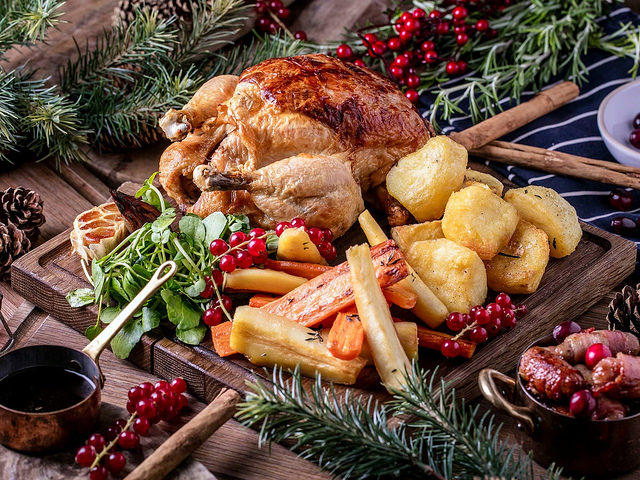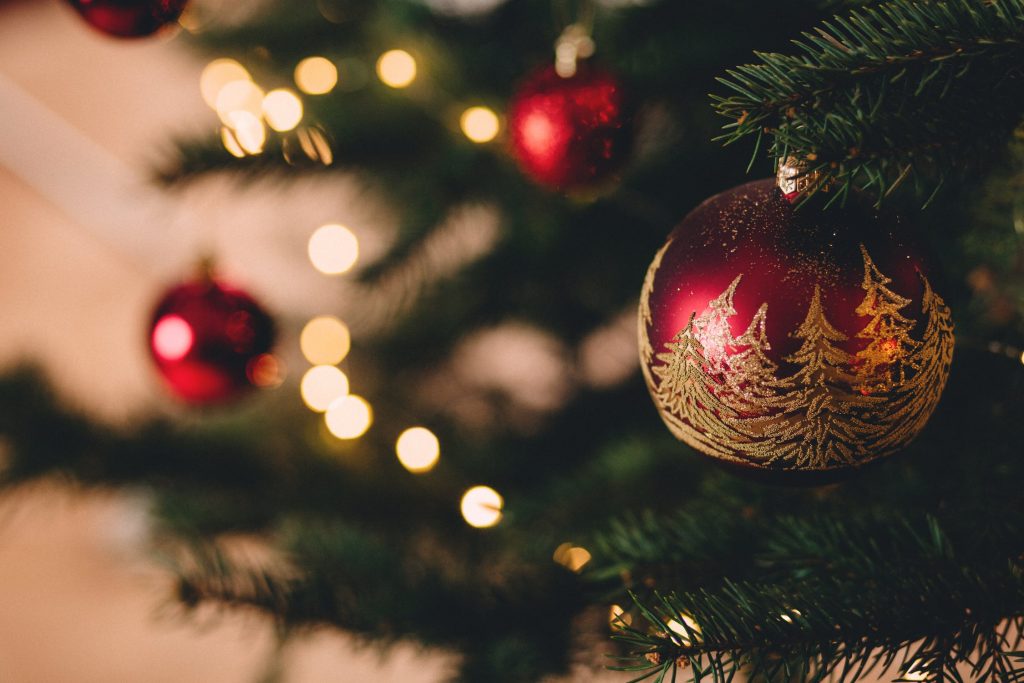 Christmas is here, which means festive lesson ideas are making their way into the EFL classroom! What better time than to take a look at Christmas vocabulary and put it into context? Although not all EFL students celebrate Christmas, it is still an important cultural holiday for English-speaking countries, so EFL students will benefit from knowing what it’s all about.
Christmas is here, which means festive lesson ideas are making their way into the EFL classroom! What better time than to take a look at Christmas vocabulary and put it into context? Although not all EFL students celebrate Christmas, it is still an important cultural holiday for English-speaking countries, so EFL students will benefit from knowing what it’s all about.
Christmas is a really interesting topic with loads of quirky traditions (and we’re not just talking about Uncle Bert’s insistence on charades before the Queen‘s speech!) So before you launch into another verse of ‘We Wish You a Merry Christmas’, hold onto your paper hats – it’s time to think about Christmas vocabulary!
Christmas Vocabulary
Christmas EFL lessons can be great fun and there are not many topics with a wider vocabulary than everything festive. From Christmas pudding and baubles to sleighs and carols – or baby Jesus and angels if you want to take a more traditional path.
Teaching Christmas vocabulary can be easy if you have the right tricks up your sleeve. The words related to Christmas can easily be put into context too, using fill-in-the-gap sheets or stories – there is so much waiting to go on in the Christmas EFL classroom!
Christmas Dinner in the UK
Christmas dinner is a great place to start for talking about food and drink vocabulary. This is always a fun topic for discussion because different countries traditionally eat different foods. In the UK, we traditionally eat turkey at Christmas. Goose is also traditional.
Christmas dinner differs from home to home, but in Britain it often consists of a some of these foods or a mixture of the following: turkey, goose, stuffing, roast potatoes, ‘pigs in blankets’ (chipolatas – little sausages – wrapped in bacon), brussel sprouts, carrots, roast parsnips, cranberry sauce, bread sauce and gravy.
For dessert (also called ‘pudding’ or ‘afters’), people in the UK eat Christmas cake, Christmas pudding and chocolate log (though probably not all at the same sitting!) Mince pies and brandy snaps are also eaten as sweet snacks.
There are many personal favourites and variations across the British Christmas dinner, but these foods are nearly always on the table at some point.
Many people drink wine with Christmas dinner. Favourite festive drinks also include sherry, port, mulled wine and Bucks Fizz.
During the Christmas dinner, people often pull colourful tubes called ‘crackers’ which make a banging sound when pulled. Crackers traditionally contain a paper hat, a small toy or game and a riddle or joke.
Nativity and Wise Men – or Christmas Pudding and Crackers?
But what about traditional ideas when it comes to telling students about Christmas? Well although it is a good idea to share some traditional Christmas ideas, don’t feel you have to get religious with your EFL lessons when it comes to Christmas.
For one thing, not all EFL students will be Christian, so it pays to be aware of cultural sensitivities in the EFL classroom.
The Nativity story, however, would certainly be a great way to bring in some more useful vocabulary – baby Jesus, the inn, the stable, the angel Gabriel, the three Wise Men, gold, frankincense, myrrh (well, perhaps not myrrh unless you’ve practiced spelling it beforehand. Yes, EFL students can ask pesky questions!)
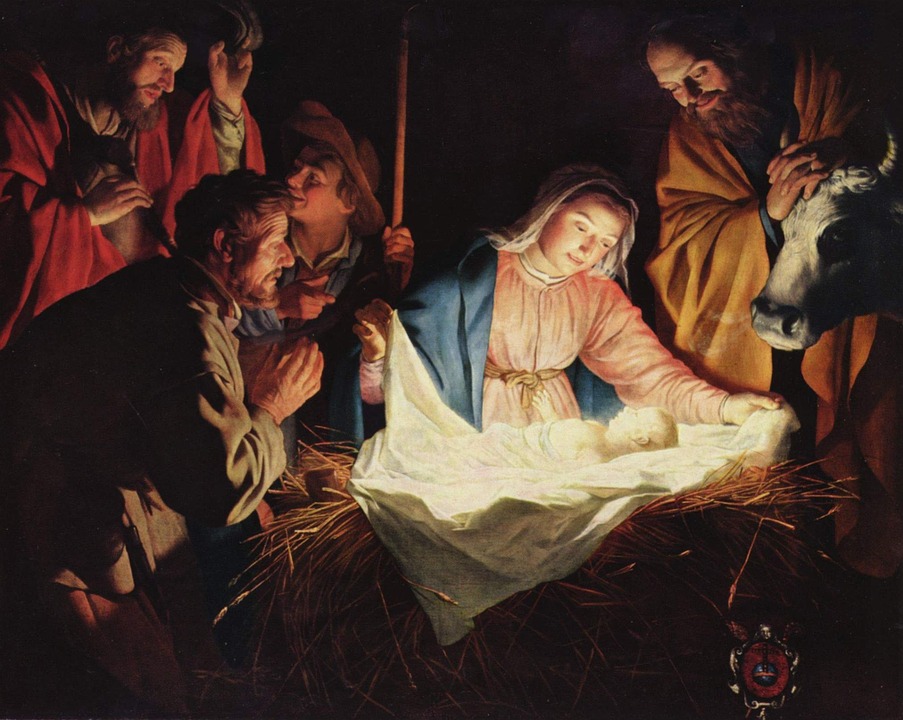
A nativity scene – image source
You can also find little figurines to create your own nativity scene, which is a great way to introduce the characters of Mary, Joseph and the Wise Men and talk about the Christmas story.
Creating a nativity scene helps teachers to introduce lots of Christmas vocabulary and this can be used to explore any grammar points needed to tell the story.
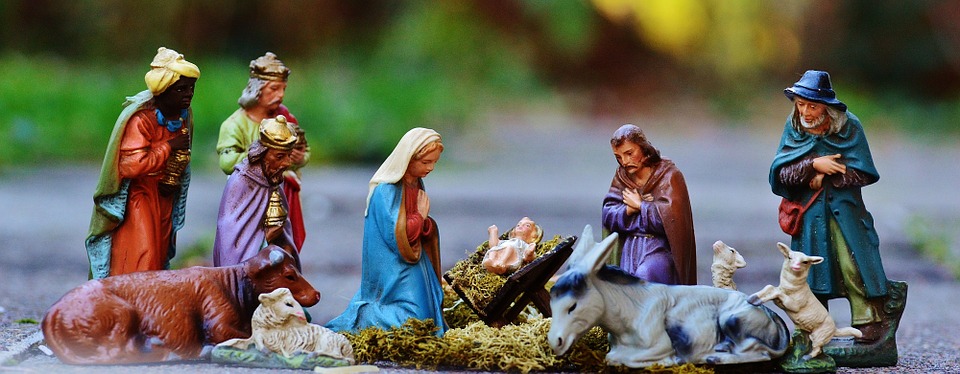
A traditional nativity scene with decorative figures – image source
Many people in the UK enjoy going to a church service at Christmas, even those who do not normally go to church at other times of year. There are traditional services with carols held on Christmas Eve, often at 11pm or midnight (‘Midnight Mass’ for Catholics).
If you prefer to leave out the religious side altogether in your EFL class, there is plenty of scope for a slightly less holy lesson.
Think about sleigh bells, holly, crackers, mistletoe, Christmas trees, mince pies, presents, charades, snow, snowmen (and snow women and children – and even snow animals) pantomimes, carols, Rudolph and friends – the list goes on.
Once you’ve introduced a few choice morsels of Christmas vocabulary, it’s important to define the words, so EFL students understand what they mean. For example, you could write the following on the board:
English Christmas Vocabulary
- Christmas Tree – a fir tree people traditionally have in their homes at Christmas time. Some people put presents around the base of the tree. The tree can be real or fake.
- Father Christmas / Santa Claus – based on St Nicholas, the legend of Father Christmas is that this magical man sets out on his sleigh pulled by reindeer on Christmas Eve and brings presents to all the children in the world. He wears a red and white costume.
- Baubles – colourful decorations in different shapes that you hang on the Christmas tree. These are traditionally made from glass
- Sleigh – a vehicle designed to travel on snow by sliding along the ground.
- Christmas stocking – a knitted sock used to hold presents, traditionally hung up over the fireplace.
- Presents – gifts given at Christmas time (also at other times of celebration, such as birthdays).
- Holly – a prickly green plant with red berries.
- Snowman – a character made from snow, often made by children at Christmas time. Often its nose is made from a carrot, its eyes from stones and arms from twigs.

A smiling snowman with a carrot for a nose Image source
- Christmas crackers – Brightly wrapped cardboard tubes shaped like large sweets, pulled apart by two people to make a ‘bang’ sound. Inside is a paper hat shaped like a crown, a small toy and a motto, riddle or joke.
- Mistletoe – a green plant with white berries often hung from the ceiling. When two people walk under it they are supposed to kiss.
- Reindeer – a type of deer from Northern Europe
- Queen’s Christmas message – a speech given by the Queen at 3pm on Christmas Day. She comments on the news from the past year and gives her good wishes and hope for the new year.
- Carols – popular religious songs or hymns traditionally sung at Christmas time
- Mince pies – a traditional small cake made of pastry and filled with fruit and mincemeat. Children traditionally leave a mince pie out for Santa on Christmas Eve, along with some milk for his reindeer!
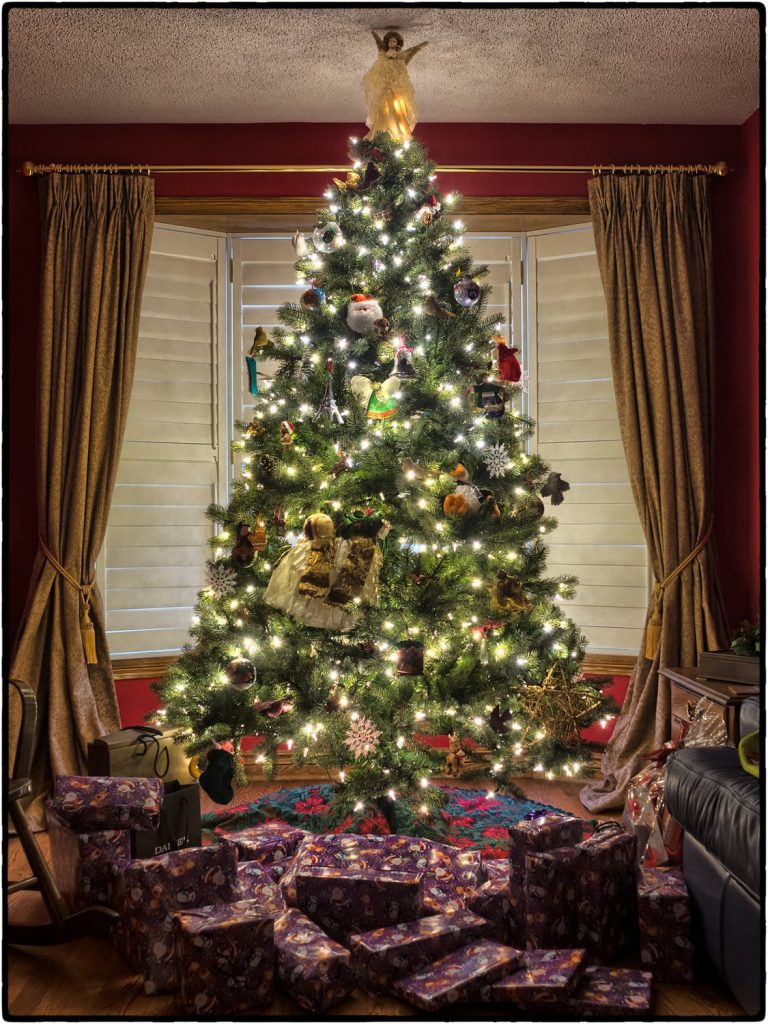
Christmas tree with presents stacked around the base – image source
Christmas Vocabulary in Context
Once you have devised a list of the best Christmas vocabulary, we have to make sure the students know what the words all mean. It’s time to put the new words into context.
Think up some good sentences or a story using the words and ask students to fill in the gaps with their newly learnt Christmas vocabulary. This is a great way to test students’ comprehension.
Students can then read out the complete sentences for pronunciation practice. It’s a good idea to tell students about the traditions associated with Christmas too, as this will help them to understand all the contextual exercises.
This can all be great fun – and you will probably get a few laughs and raised eyebrows at some of the traditions that we take for granted here in the UK!
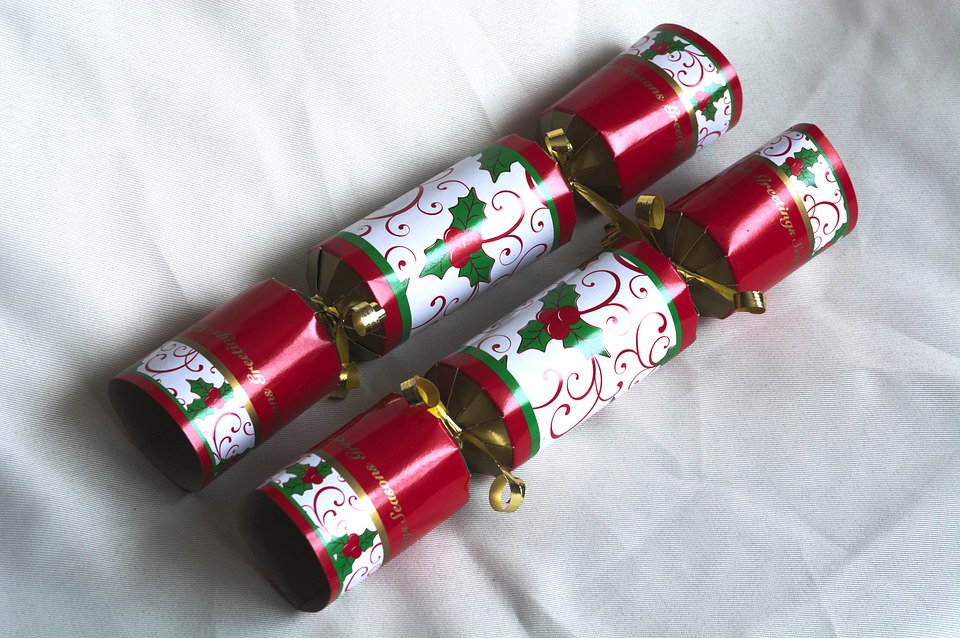
Christmas crackers are often placed by the plates on the dinner table – image source
Gap Fill Exercise with Christmas Vocabulary:
- Rudolph is a famous red-nosed ………. He lives in the North Pole. When Santa goes out on Christmas Eve to deliver all the ……… to the boys and girls, Rudolph and his friends pull the ………
- At Christmas time the weather is very cold in the UK and sometimes there is a white blanket of …. on the ground. On the hedgerows there can be ………. growing with its red berries shining brightly. Many people pick this plant and put it in their homes for decoration
- Another plant associated with Christmas is ………… People hang it in their homes from the ceiling or over doorways and tradition dictates that when two people walk under it, they are supposed to kiss.
- People often put their presents around the base of the ………. and others put them in a ……….. and hang it from the mantelpiece.
- There is always lots of special food and drink around at Christmas time. Traditional sweet foods include Christmas pudding, brandy snaps and ………. which are delicious eaten sprinkled with sugar. Don’t forget to save one of these to leave out for Santa on Christmas Eve!
- Christmas ………. are often part of Christmas celebrations in the UK. These brightly coloured cardboard tubes make a ‘bang’ sound when pulled apart by two people. There are always fun items inside: traditionally a colourful paper ……… , a small ………. and a ……….
- People traditionally sing ………… at Christmas time. These are popular religious ………. or hymns.
- The Queen traditionally gives a ………. at 3 O’clock on Christmas Day. This is broadcast across the UK on television and radio. The speech is known as the Queen’s Christmas ………..
After filling in the gaps, the students can write their own sentences using Christmas vocabulary, letting them be as creative as they like. They might come up with some new traditions!
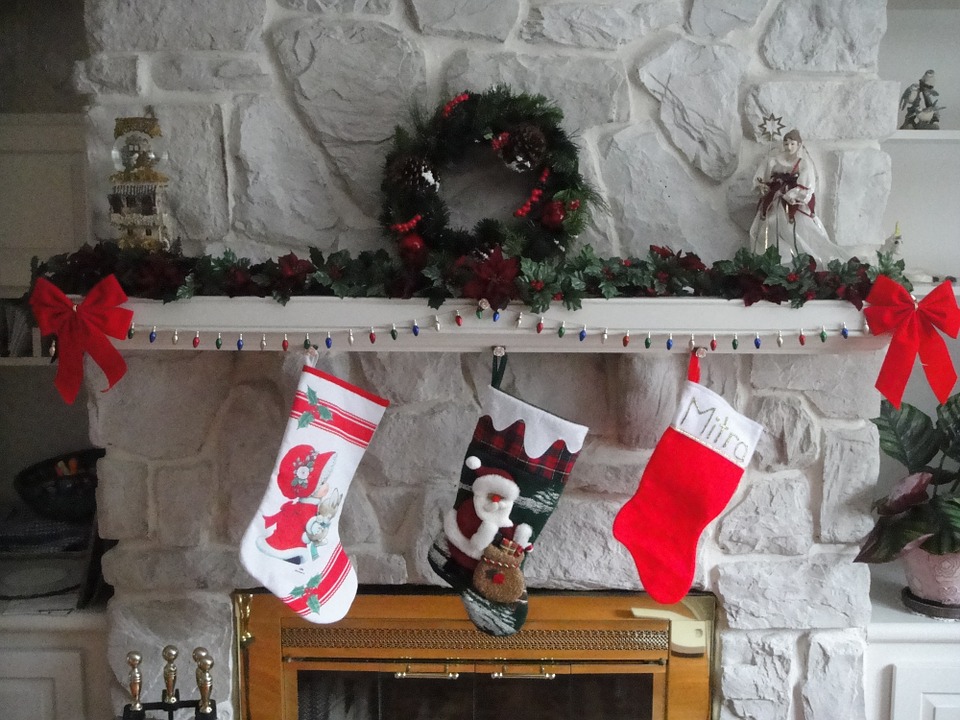
Christmas stockings hanging from the mantel piece – image source
Christmas Songs for EFL Practice
Christmas songs are also great for teaching vocabulary. Christmas carols, such as Away in a Manger, Good King Wenceslas and The Holly and the Ivy are always firm favourites.
Take care with Christmas carols though because some of the words can be archaic and difficult for beginners, so pick your carols carefully.
Pop songs and children’s songs can be ideal as they are simpler, from White Christmas and All I Want for Christmas (is my Two Front Teeth) to Jingle Bells and Rudolph the Red-nosed Reindeer!
PPP Technique for Christmas Lessons
This lesson idea is a great example of the PPP Technique of teaching, that is: Presentation, Practice and Production. First present the Christmas vocabulary, then have the students practice it, then finally let the students produce it on their own.
Christmas is always great fun in the EFL classroom!
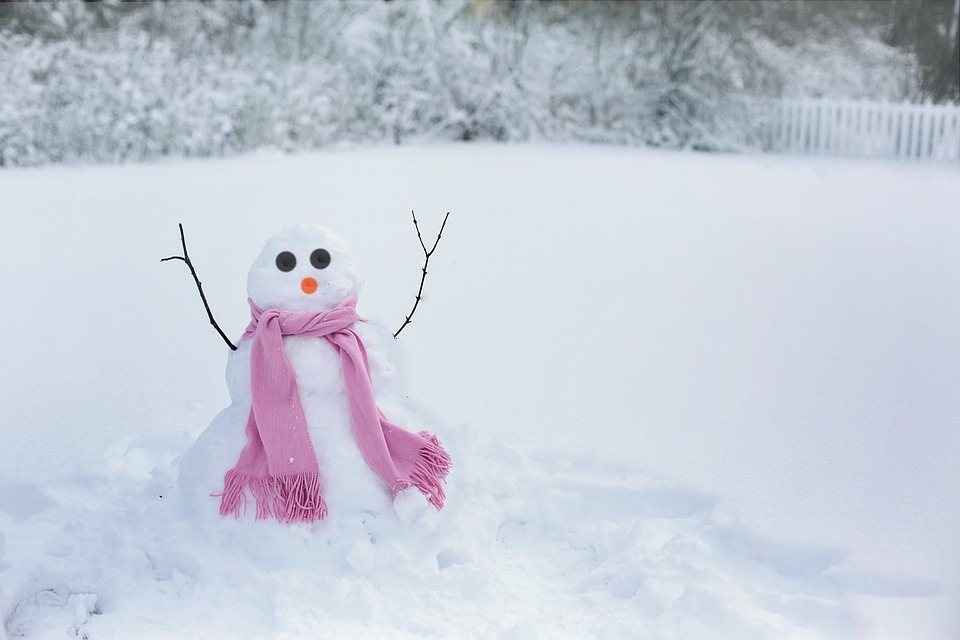
A snow woman (you can tell by the pink scarf!) – image source
Share your ideas about Christmas EFL lessons
What are your favourite Christmas traditions?
What do you eat for Christmas dinner in your country?
Do you find any of the UK Christmas traditions strange or funny?
Teachers, do you have any other ideas for Christmas vocabulary practice?
Attributions
- Best of British Food – Christmas by Paul Townsend via Flickr [CC BY-SA 2.0]

